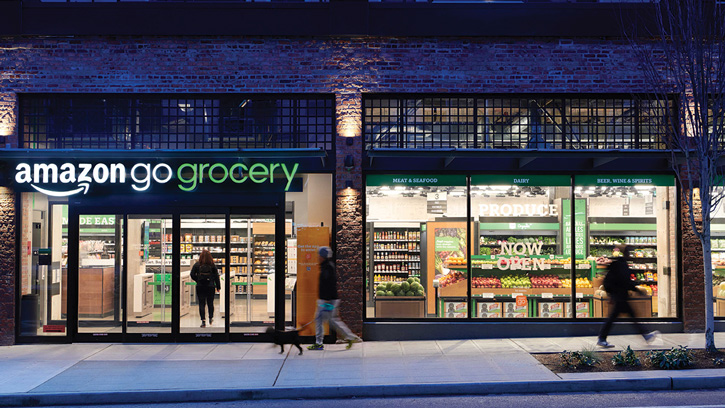Robotic Automation Is Transforming Grocery Retail
IFTNEXT
Earlier this year, Walmart unveiled its Alphabot robotic system, an automated system that is set to revolutionize grocery order fulfillment by enabling quicker, more efficient order picking. Operating inside a 20,000-square-foot warehouse-style space, Alphabot uses autonomous carts to retrieve ambient, refrigerated, and frozen items ordered online for grocery pickup. After it retrieves the items, Alphabot delivers the products to a workstation, where a Walmart associate checks, bags, and delivers the final order.
Alphabot merges e-commerce and brick and mortar methods of serving customers, and it may be a harbinger of things to come. “By assembling and delivering orders to associates, Alphabot is streamlining the order process, allowing associates to do their jobs with greater speed and efficiency,” says Brian Roth, Walmart’s senior manager of pickup automation and digital operations. “Ultimately, this will lower dispense times, increase accuracy, and improve the entirety of online grocery. And it will help free associates to focus on service and selling, while the technology handles the more mundane, repeatable tasks.”
As customers continue to demand e-commerce options, the online grocery order business is expected to continue growing—especially in the new reality of social distancing to help avoid the novel coronavirus that causes COVID-19. As grocers attempt to ride out the current pandemic, as well as meet customers’ expectations into the future, automated technologies, such as Alphabot, will help them keep up.
For example, according to research from McKinsey, retailers are experiencing increasing margin pressure as a result of intense competition and investments in e-commerce. Typically, grocery retailers are facing 100 to 150 basis points of margin pressure. “While cost pressures are not new, many retailers have already exhausted traditional cost-reduction levers,” the researchers wrote in the report—Automation in retail: An executive overview for getting ready. “Unable to pass on costs to their customers in this hypercompetitive environment, retailers are using automation to support and bolster margins.”
Generally, automation technologies are available to close the gap, but most grocery retailers are not ready to deploy all the technologies that could improve their margins. McKinsey researchers’ assessment of available automation technologies shows that a typical grocery store could already operate with up to 55%–65% fewer staff hours. Those technologies include electronic shelf-edge labels, self-checkout terminals, shelf-scanning robots, and partially automated backroom unloading.
Few food retailers are prepared to completely overhaul their business models to accommodate available technologies, but many, like Walmart, are taking steps toward increased automation. For instance, in 2018, Kroger launched Kroger Edge, digital shelves that display prices, nutrition facts, coupons, and video ads, which can all be updated from a central source. The plan is to eventually link the shelves to shoppers’ smartphones to allow for more personalization.
And in February, Amazon rolled out its first large grocery store with Amazon “Go” technology, which allows grocery shopping without any checkout procedures. The store uses computer vision, sensor fusion, and deep learning technologies to allow customers to truly “grab and go,” with no checkout lines or cashiers. The technology automatically detects when products are taken from or returned to the shelves and keeps track of them in each shopper’s virtual cart. Shoppers’ Amazon accounts are charged for purchases when they exit the store. While the new store, located in Seattle, is the first full-size grocery store of its type—spanning more than 10,000 square feet—the company was already operating 25 Amazon Go convenience stores with the same concept.
Ideal for the age of social distancing, Amazon’s touchless system will eventually be available for other retailers to use in their stores. The company aims to use its Seattle grocery store to showcase the technology and how it works for other retailers who may be interested. A variety of different revenue models have been discussed, including a fixed licensing fee or a revenue-sharing agreement.
Consumers’ appetites for online grocery ordering and other quick, convenient methods of food shopping have been increasing for several years. However, the coronavirus pandemic and the necessary social distancing that came with it may serve as further motivation for automated shopping. In response, grocery retailers are expected to continue shifting their business models to include more automated technologies and opportunities for customers to acquire the items they need with little personal interaction.


